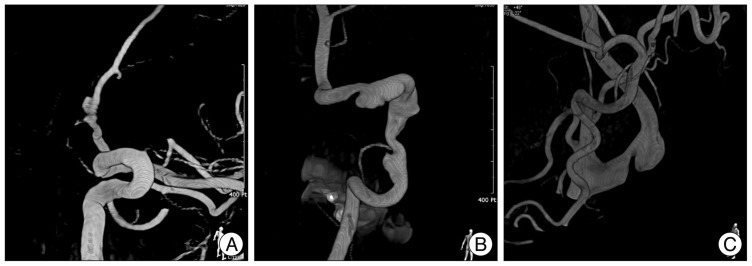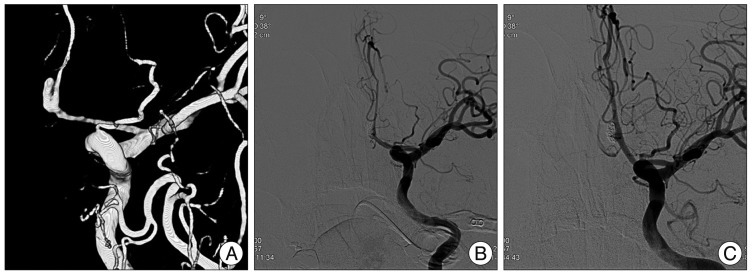J Korean Neurosurg Soc.
2013 Feb;53(2):115-117. 10.3340/jkns.2013.53.2.115.
Spontaneous Anterior Cerebral Artery Dissection Presenting with Simultaneous Subarachnoid Hemorrhage and Cerebral Infarction in a Patient with Multiple Extracranial Arterial Dissections
- Affiliations
-
- 1Department of Neurosurgery, Hanyang University Medical Center, Seoul, Korea. hjyi8499@hanyang.ac.kr
- 2Department of Radiology, Hanyang University Medical Center, Seoul, Korea.
- 3Department of Neurology, Hanyang University Medical Center, Seoul, Korea.
- KMID: 2190689
- DOI: http://doi.org/10.3340/jkns.2013.53.2.115
Abstract
- Simultaneous subarachnoid hemorrhage and infarction is a quite rare presentation in a patient with a spontaneous dissecting aneurysm of the anterior cerebral artery. Identifying relevant radiographic features and serial angiographic surveillance as well as mode of clinical manifestation, either hemorrhage or infarction, could sufficiently determine appropriate treatment. Enlargement of ruptured aneurysm and progressing arterial stenosis around the aneurysm indicates impending risk of subsequent stroke. In this setting, prompt treatment with stent-assisted endovascular embolization can be a reliable alternative to direct surgery. When multiple arterial dissections are coexistent, management strategy often became complicated. However, satisfactory clinical results can be obtained by acknowledging responsible arterial site with careful radiographic inspection and antiplatelet medication.
Keyword
MeSH Terms
Figure
Cited by 1 articles
-
Two Cases of Subarachnoid Hemorrhage from Spontaneous Anterior Cerebral Artery Dissection : A Case of Simultaneous Hemorrhage and Ischemia Without Aneurysmal Formation and Another Case of Hemorrhage with Aneurysmal Formation
Tae-Seop Im, Yoon-Soo Lee, Sang-Jun Suh, Jeong-Ho Lee, Kee-Young Ryu, Dong-Gee Kang
J Cerebrovasc Endovasc Neurosurg. 2014;16(2):119-124. doi: 10.7461/jcen.2014.16.2.119.
Reference
-
1. Amagasaki K, Yagishita T, Yagi S, Kuroda K, Nishigaya K, Nukui H. Serial angiography and endovascular treatment of dissecting aneurysms of the anterior cerebral and vertebral arteries. Case report. J Neurosurg. 1999; 91:682–686. PMID: 10507393.
Article2. Huang YC, Chen YF, Wang YH, Tu YK, Jeng JS, Liu HM. Cervicocranial arterial dissection : experience of 73 patients in a single center. Surg Neurol. 2009; 72(Suppl 2):S20–S27. discussion S27. PMID: 19150115.3. Inoue T, Fujimura M, Matsumoto Y, Kondo R, Inoue T, Shimizu H, et al. Simultaneous occurrence of subarachnoid hemorrhage and cerebral infarction caused by anterior cerebral artery dissection treated by endovascular trapping. Neurol Med Chir (Tokyo). 2010; 50:574–577. PMID: 20671384.
Article4. Jensen MB, Chacon MR, Aleu A. Cervicocerebral arterial dissection. Neurologist. 2008; 14:5–6. PMID: 18195650.
Article5. Kitanaka C, Tanaka J, Kuwahara M, Teraoka A, Sasaki T, Takakura K, et al. Nonsurgical treatment of unruptured intracranial vertebral artery dissection with serial follow-up angiography. J Neurosurg. 1994; 80:667–674. PMID: 8151345.
Article6. Koyama S, Kotani A, Sasaki J. Spontaneous dissecting aneurysm of the anterior cerebral artery : report of two cases. Surg Neurol. 1996; 46:55–61. PMID: 8677490.
Article7. Kurino M, Yoshioka S, Ushio Y. Spontaneous dissecting aneurysms of anterior and middle cerebral artery associated with brain infarction : a case report and review of the literature. Surg Neurol. 2002; 57:428–436. discussion 436-438. PMID: 12176212.
Article8. Ohkuma H, Suzuki S, Kikkawa T, Shimamura N. Neuroradiologic and clinical features of arterial dissection of the anterior cerebral artery. AJNR Am J Neuroradiol. 2003; 24:691–699. PMID: 12695205.9. Redekop GJ. Extracranial carotid and vertebral artery dissection : a review. Can J Neurol Sci. 2008; 35:146–152. PMID: 18574926.10. Sato S, Toyoda K, Matsuoka H, Okatsu H, Kasuya J, Takada T, et al. Isolated anterior cerebral artery territory infarction : dissection as an etiological mechanism. Cerebrovasc Dis. 2010; 29:170–177. PMID: 19955742.
Article11. Suzuki K, Mishina M, Okubo S, Abe A, Suda S, Ueda M, et al. Anterior cerebral artery dissection presenting subarachnoid hemorrhage and cerebral infarction. J Nippon Med Sch. 2012; 79:153–158. PMID: 22687360.
Article12. Yonas H, Agamanolis D, Takaoka Y, White RJ. Dissecting intracranial aneurysms. Surg Neurol. 1977; 8:407–415. PMID: 594878.
- Full Text Links
- Actions
-
Cited
- CITED
-
- Close
- Share
- Similar articles
-
- Two Cases of Subarachnoid Hemorrhage from Spontaneous Anterior Cerebral Artery Dissection : A Case of Simultaneous Hemorrhage and Ischemia Without Aneurysmal Formation and Another Case of Hemorrhage with Aneurysmal Formation
- Simultaneous Occurrence of Cerebral Infarction and Subarachnoid Hemorrhage due to Anterior Cerebral Artery Dissection Treated by Bypass Surgery and Coil Embolization
- Reversible Cerebral Vasoconstriction Syndrome with Concurrent Anterior Cerebral Artery Dissection
- Simultaneous Nonaneurysmal Subarachnoid Hemorrhage and Acute Cerebral Infarction in a Patient with Intracranial Atherosclerosis
- Cerebral Artery Dissection: Spectrum of Clinical Presentations Related to Angiographic Findings




